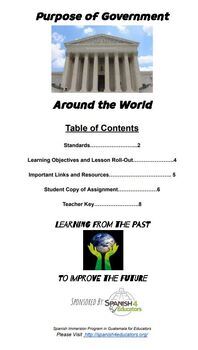Purpose of Government Around the World
- Google Docs™

Description
This resource is a great way to get your government students thinking critically and WHY..... WHY do we have a government and how do they interact with the people?
Included in this resource is a deep-dive into some major Enlightenment Thinkers such as Hobbes and Locke around the history of the philosophy of governments. In addition, embedded in this lesson are two different opportunities for student debate / discourse, including the following prompts:
- Which philosopher above do you agree with the most? Why?
- How do you feel religion should relate to the government? Why?
- How much power should the government have over the people? Why do you feel this way?
- Which of the six purposes of the US Preamble is MOST IMPORTANT in your opinion? Why?
Your students will also take a look at Constitution Preambles from other countries OUTSIDE OF the US, in order to gain perspective on the purposes of governments around the world.
Included with this resource include bonus vocabulary words (with cited definitions, teacher answer key, and sample debate norms!





